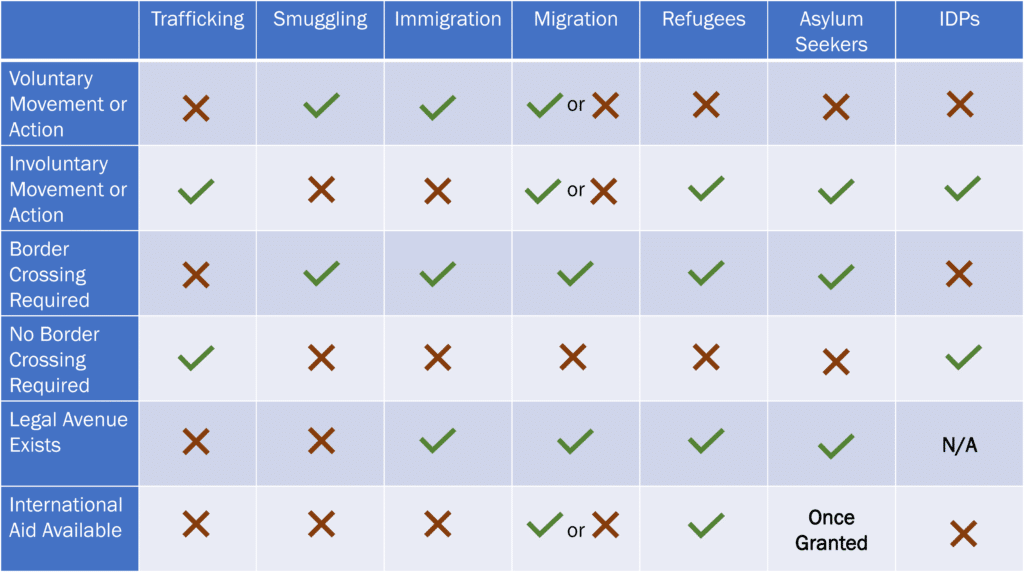Human Trafficking, Human Smuggling, Migration, Immigration, Refugees, and Asylum Seekers are labels for people that are often and easily confused.
Explaining any one of these terms requires an in-depth look at its context in the United States and around the world. It’s important to understand the differences between these terms for two reasons. First, these terms are used so often online and in the news that they can start to read as one large issue. But, these concepts are each unique and deserve to be understood in their own context. Second, you can’t be a better neighbor or a better advocate unless you understand the nuances and the needs. In this post, we will illustrate the key differences between each of these groups and provide resources for further learning.
Human Trafficking
In short, human trafficking is the sale of a person for sex, labor, or organs, to a buyer who exploits that victim.
In case you missed it, we take a detailed look at what human trafficking is, who it affects, and where it is happening in our Human Trafficking 101 series. To catch up, read our Human Trafficking 101 series.
Although the word trafficking makes us think of movement, one important thing to remember is that no transportation is required for human trafficking to take place.
Human Smuggling
One of the most common misunderstandings is the confusion between human trafficking and human smuggling. They are not the same thing.
Human smuggling is a type of illegal immigration. It is the act of concealing a person to cross a border illegally. In most cases, an individual voluntarily pays someone (a smuggler) to facilitate their transportation into another country. He or she is choosing of their own will to cross the border.
There are many reasons a person may be compelled to illegally cross a border. Often, they are looking for a better life, or are seeking to be reunited with loved ones who are already on the other side of the border.
Whatever the reason, it is important to understand that human smuggling always begins as a voluntary exchange – without the key elements that would make it trafficking (force, fraud, coercion or exploitation of a minor.)
To illustrate, consider the case in San Antonio, TX last year where dozens of immigrants were found in the back of a tractor trailer in a parking lot. It is believed that the truck had held upwards of 90 individuals. The temperature in the truck was well over 100°F, the immigrants had reportedly paid to be smuggled, and they had been told that the truck was climate controlled. The truck driver, James Bradley, Jr. initially denied knowing there were people in the truck, but later pled guilty to many criminal charges, including human smuggling. 
National and local news stations reported this story using human trafficking and human smuggling interchangeably. For example, this local newspaper referred to this event as “human trafficking” in the title, but then refers to it as “human smuggling” in the article. Both Fox News and The Huffington Post wrongly refer to this case as human trafficking, based on statements in a news release. And perhaps because they could not sparse out the details, CNN addressed the San Antonio human trafficking and human smuggling in a broader article.
Even though the deadly conditions were atrocious and the immigrants were deceived about the conditions they would travel in, this case does not meet the law’s requirements for human trafficking. These individuals were not being sold for sex or for labor. There was no force, fraud, or coercion reported by the surviving individuals – they chose to accompany a smuggler across the border. What happened to these immigrants was horrifying and wrong, but this case of human smuggling was not human trafficking.
Migrants
The International Organization for Migration defines a migrant as, “any person who is moving or has moved across an international border or within a State away from his/her habitual place of residence, regardless of (1) the person’s legal status; (2) whether the movement is voluntary or involuntary; (3) what the causes for the movement are; or (4) what the length of the stay is.” Therefore, the terms migration and migrant refer to people of all backgrounds, race, religion, socioeconomic background, education level, and legal status. People who are migrants can be immigrants (both authorized and unauthorized), refugees, asylum seekers, human trafficking victims who crossed an international border, etc.
In December 2017, the UN estimated that there were 258 million people living outside of their birth country, which has increased 49% over the last two decades.
However, though the term migrant is used very broadly internationally, it has a much narrower meaning in the United States. Most people in the US interpret migrant to mean a seasonal day laborer who works in agriculture, ranching, or another outdoor occupation. In fact, Merriam-Webster defines migrant as, “a person who moves regularly in order to find work especially in harvesting crops.” The assumption is often made that these workers are unauthorized.
It is important to understand the competing definitions of this term when you read an article or news story. Determine the author’s context and how the term is being used to fully understand what the article is trying to convey.
Immigrant
All immigrants are migrants, but not all migrants are immigrants.
An immigrant is someone who voluntarily leaves their country to settle permanently or for an extended time in another country. Immigration may occur via a legal process or outside of a legal system. Immigrants live, work, go to school, and engage in new communities in the same way permanent residents do. Many people immigrate for better educational or career opportunities or to join family members already in a new country. Some individuals immigrate alone, some immigrate as an entire family, and some families immigrate in stages.
Immigrant is a word used primarily in the United States. Usually, it refers to the influx of individuals into the US. Immigrants in the US are commonly talked about in two categories – legal and illegal – though the practical application of those terms in the US is much more complicated and nuanced than vague labels.
According to Migration Policy Institute:
- More than 43.7 million immigrants resided in the United States in 2016, accounting for 13.5 percent of the total U.S. population. Immigrants and their U.S.-born children now number approximately 86.4 million people, or 27 percent of the overall U.S. population.
- In 2016, India was the leading country of origin for US immigrants. China/Hong Kong, Mexico, Cuba, and the Philippines round out the top five countries of origin.
- Immigrants make up 17% of the US workforce, primarily in the industries of management, business, science, and the arts.
There are an estimated 9 million US emigrants living abroad.
Refugees, Asylum Seekers, and Internally Displaced Persons
One out of every 113 people on earth is either a refugee, asylum seeker, or an internally displaced person. More people are displaced in our world than ever before.
Refugee
According to UNHCR, “A refugee is someone who has been forced to flee his or her country because of persecution, war, or violence. A refugee has a well-founded fear of persecution for reasons of race, religion, nationality, political opinion or membership in a particular social group. Most likely, they cannot return home or are afraid to do so. War and ethnic, tribal and religious violence are leading causes of refugees fleeing their countries. More than half of all refugees worldwide come from just three countries: Syria, Afghanistan and South Sudan.”
Approximately 20% – 30% of refugees live in refugee camps. Many people automatically think of expansive desert refugee camps when they picture a refugee fleeing from her country. While refugee camps are intended to be emergency short-term shelters, they are often permanent fixtures. Though the camps often have limited access to clean water, food, and infrastructure, many refugees are forced to recreate small functioning communities in these tent cities because they cannot lawfully go elsewhere and they cannot return home.
Most of the remaining refugee populations live in urban areas, where they may live without the legal right for employment, education, healthcare, and housing. In many cases, refugees have the compounding issue of a language barrier and unfamiliarity with the nation’s laws. These vulnerabilities can make refugees a target for human traffickers.
Internally Displaced Person
An internally displaced person (IDP) is someone who has been forced to flee his or her home because of a natural disaster, persecution, war, or violence but still resides in their home country. UNHCR explains, “These individuals seek safety anywhere they can find it—in nearby towns, schools, settlements, internal camps, even forests and fields”. Though refugees and IDPs share many of the same characteristics and challenges, IDPs do not have a special status under international law. Because they are considered to be under the protection of their own government, they are not entitled to international humanitarian assistance.
Asylum Seeker
An asylum seeker is a person who has filed for legal refugee status in a host country and is awaiting approval to be resettled. When asylum is granted, a person is recognized as a refugee who can receive legal protections, material assistance, and in some cases, direct services. Internationally, all officially resettled refugees were once asylees.
However, in the United States refugees and asylees are defined differently. According to the Migration Policy Institute, “In the United States, the major difference between refugees and asylees is the location of the person at the time of application. Refugees are usually outside of the United States when they are screened for resettlement, whereas asylum seekers submit their applications while they are physically present in the United States or at a U.S. port of entry. Refugees and asylees also differ in admissions process used and agency responsible for reviewing their application.” The Migration Policy Institute also states that:
- In 2016, an estimated 115,399 affirmative asylum applications were filed with U.S. Citizenship and Immigration Services (USCIS).
- In FY 2016, 20,455 individuals, including principal applicants and their spouses and/or unmarried children under age 21, were granted asylum after seeking protection upon or after arrival in the United States
- China remained the top country of origin for affirmative asylum applications, with 16,490 in FY 2016; followed by 14,773 from Venezuela and 14,663 from Mexico.
To learn more about the different ways of obtaining asylum in the United States, click here.
Compare/Contrast
Though there will always be exceptions, here is one way to understand the similarities and differences between each of these groups.

What’s Next?
If you feel passionate about the issues of refugees and resettlement, explore the nine national resettlement agencies and look for an office near your city that could use your time, talents, and support.
Ethiopian Community Development Council
Episcopal Migration Ministries
International Rescue Committee
Lutheran Immigration and Refugee Service
U.S. Committee for Refugees and Immigrants
United States Conference of Catholic Bishops/Migration and Refugee Services
For further learning, explore these media resources
Migration Policy Institute Podcasts

